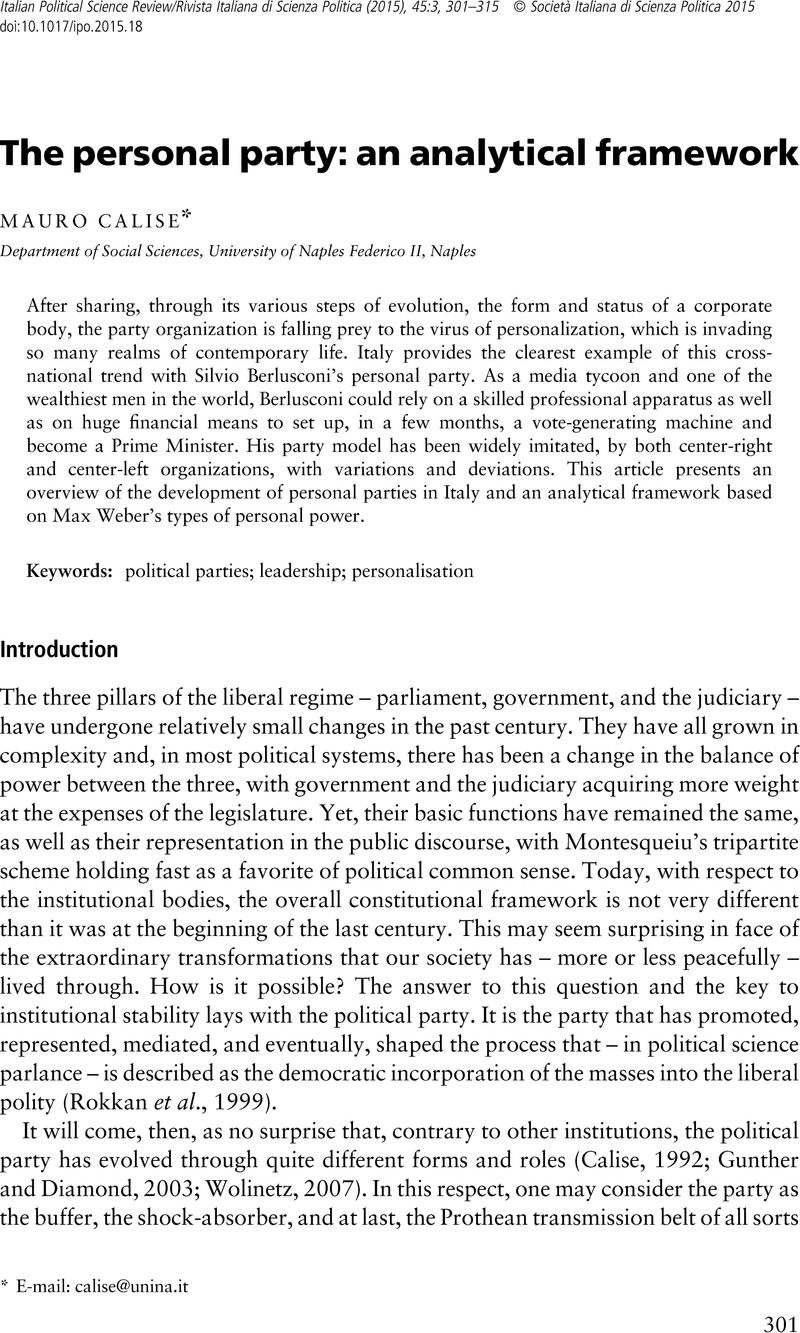Crossref Citations
This article has been cited by the following publications. This list is generated based on data provided by Crossref.
Fasano, Luciano M.
and
Seddone, Antonella
2016.
Selecting the leader, Italian style.
Contemporary Italian Politics,
Vol. 8,
Issue. 1,
p.
83.
Regalia, Marta
2018.
Electoral Reform as an Engine of Party System Change in Italy.
South European Society and Politics,
Vol. 23,
Issue. 1,
p.
81.
Musella, Fortunato
2018.
Political Leaders Beyond Party Politics.
p.
31.
Kefford, Glenn
and
McDonnell, Duncan
2018.
Inside the personal party: Leader-owners, light organizations and limited lifespans.
The British Journal of Politics and International Relations,
Vol. 20,
Issue. 2,
p.
379.
Musella, Fortunato
2018.
Political Leaders Beyond Party Politics.
p.
65.
Musella, Fortunato
2018.
Political Leaders Beyond Party Politics.
p.
1.
Albertazzi, Daniele
Giovannini, Arianna
and
Seddone, Antonella
2018.
‘No regionalism please, we are Leghisti !’ The transformation of the Italian Lega Nord under the leadership of Matteo Salvini.
Regional & Federal Studies,
Vol. 28,
Issue. 5,
p.
645.
Kosiara-Pedersen, Karina
2019.
Change and Stability. How the Party Leaderships of the Danish Progress Party and Danish People’s Party are Organized.
Polish Political Science Review,
Vol. 7,
Issue. 1,
p.
61.
Lisi, Marco
2019.
Party innovation, hybridization and the crisis: the case of Podemos.
Italian Political Science Review/Rivista Italiana di Scienza Politica,
Vol. 49,
Issue. 3,
p.
245.
Giglioli, M. F. N.
2020.
Plutocratic leadership in the electoral arena: three Mitteleuropean cases of personal wealth in politics.
Comparative European Politics,
Vol. 18,
Issue. 3,
p.
309.
Musella, Fortunato
2020.
The personalization of Italian political parties in three acts.
Contemporary Italian Politics,
Vol. 12,
Issue. 4,
p.
411.
Emanuele, Vincenzo
Maggini, Nicola
and
Paparo, Aldo
2020.
The times they are a-changin’: party campaign strategies in the 2018 Italian election.
West European Politics,
Vol. 43,
Issue. 3,
p.
665.
Truglia, Francesco Giovanni
and
Zeli, Alessandro
2020.
Spatial analysis of economic and social determinants of vote: the case of the European Parliament and constitutional referendum votes in Italy.
Italian Political Science Review/Rivista Italiana di Scienza Politica,
Vol. 50,
Issue. 2,
p.
173.
Jacuński, Michał
Brodzińska-Mirowska, Barbara
Pacześniak, Anna
and
Wincławska, Maria
2021.
Party Organization and Communication in Poland.
p.
61.
2021.
Nouvelle sociologie politique de la France.
p.
263.
Jacuński, Michał
Brodzińska-Mirowska, Barbara
Pacześniak, Anna
and
Wincławska, Maria
2021.
Party Organization and Communication in Poland.
p.
1.
Scarrow, Susan E.
Webb, Paul D.
and
Poguntke, Thomas
2022.
Intra-party decision-making in contemporary Europe: improving representation or ruling with empty shells?.
Irish Political Studies,
Vol. 37,
Issue. 2,
p.
196.
Lioy, Alberto
2023.
“Not To Be Taken Personally”: Tracing Six Decades of Scholarship on Personal, Personalist, and Personalized Political Parties (1960–2021).
Political Studies Review,
Vol. 21,
Issue. 4,
p.
825.
Loner, Enzo
2023.
Winners or losers? Using Twitter to evaluate how the COVID-19 pandemic changed the images of political leaders in Italy.
Contemporary Italian Politics,
Vol. 15,
Issue. 4,
p.
450.
Masi, Beniamino
and
Pizzimenti, Eugenio
2023.
The political foundations of party organizational variance.
Comparative European Politics,
Vol. 21,
Issue. 1,
p.
1.



